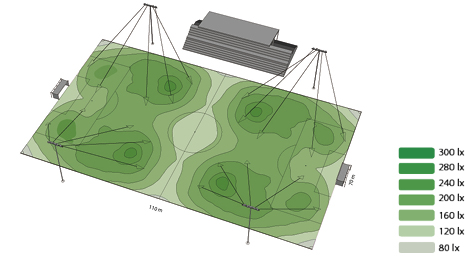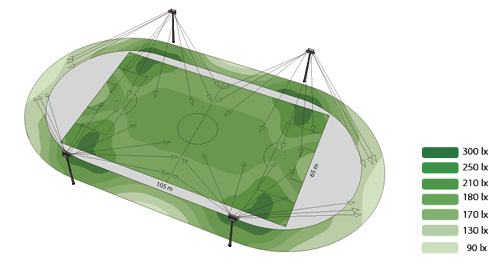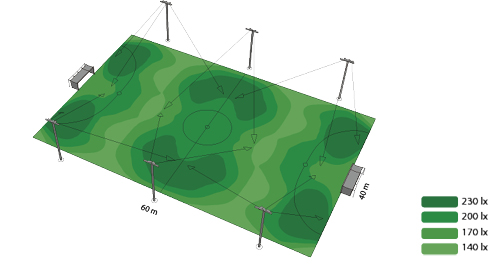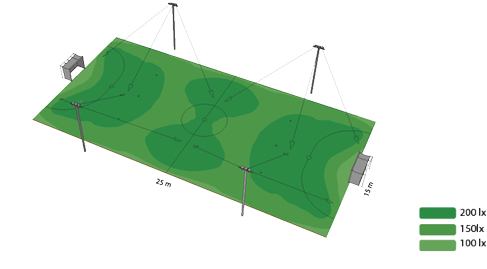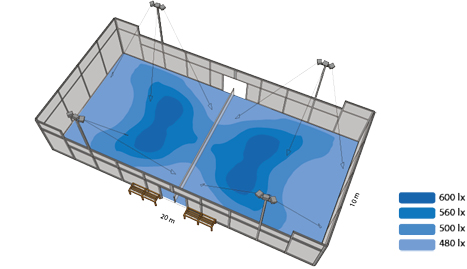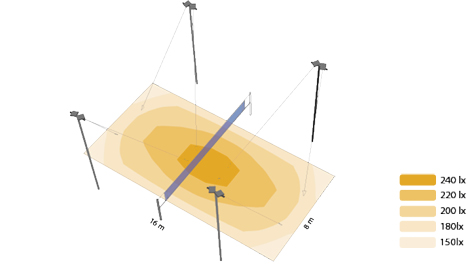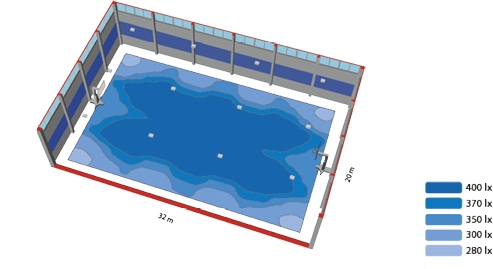One of the most common relamping interventions is the LED conversion of sports lighting systems and high mast lighting towers.
Typically, metal halide lighting fixtures on sports fields are at 1,500 W and therefore are very expensive due to a high energy absorption.
Luxi LED floodlights for sports facilities and for mounting on light towers in large industrial areas are available from 220W to 1,200W with symmetric and asymmetrical optics with light beam opening angles that can be customized to distribute the appropriate light levels on a surface of game and on a moving area for men, machinery and goods, all reducing glare.
The Luxi offer is then completed with modular and scalable wireless solutions for the automation and diagnostics of luminaires installed on light towers based on wireless Mesh Network technology, where each node receives, regenerates and retransmits the signals received, thus allowing to extend the ‘overall coverage area of the wireless network, exceeding the limit on the maximum transmission distance between two nodes. This allows you to create alternative routes to reach all the nodes in the system, making the system extremely robust even in the event of a failure in part of the installed nodes.
CASE STUDIES
Each sports field is unique. Consequently, each field will require an appropriate design solution for its intended use and the relevant lighting level.
DESIGN REQUIREMENTS
When designing the lighting of a sports field, indoor or outdoor, it is essential to put firstly the comfort and performance of the players who must not be obstructed by the lights nor should the ability of the match officials to arbitrate effectively be influenced.
A spectator should then be able to watch and enjoy the match without suffering any discomfort caused by the field lighting system which must also be able to respond to the needs of television broadcasters if matches of a certain importance are played.
The lighting system should also provide a long-term solution that is efficient and economic in line with the latest regulations on environmental impact and sustainability.
The lighting criteria relevant from the point of view of sports lighting are:
- horizontal illuminance
- vertical illuminance
- uniformity
- limitation of modeled glare and shadows
- color of light and color rendering
What are the main reference standards?
The reference standards are UNI EN 12193, relating to the recommended lighting characteristics for sports facilities, UNI EN 12665, CEI 64-8 variant V2 (electrical systems for public lighting) and, finally, UNI EN ISO 9001.
The lighting of large external industrial areas such as goods sorting areas, transit areas for vehicles and men, outdoor storage areas, for protectionist purposes, falls within the scope of the Consolidated Law on Safety at Work, Italian Legislative Decree 81/08, in broad concept of workplaces if pertaining to the company or production unit accessible to the worker in the ambit of his / her job.
The UNI EN 12464-2 standard of January 2008, Annex A, specifies the lighting requirements to guarantee sufficient levels of visual comfort and visual performance for workers who carry out their work in outdoor environments.
The UNI EN 12464-2 standard specifies the requirements for lighting in most outdoor workplaces and their related areas in terms of quantity and quality of lighting. To allow operators to perform outdoor activities efficiently and accurately, especially during the night, adequate and appropriate lighting must be guaranteed. Lighting, degree of visibility and visual comfort required, depend on the type and duration of outdoor work.
For good lighting, it is essential that, in addition to the required lighting, other qualitative and quantitative needs are met. The lighting requirements go through the satisfaction of three basic human needs:
- visual comfort – when workers have a feeling of well-being, which, indirectly, also contributes to creating a high level of productivity;
- visual performance – when workers are able to perform their visual tasks, even in difficult circumstances and over long periods;
- safety.
The main parameters to consider in the design phase are: the distribution of luminances; the illuminance; glare; the intrusive light; the direction of the light; the color rendering and the appearance of the color of the light; flicker and stroboscopic effects; the maintenance factor; energy saving.
ITALIAN CONTRIBUTIONS
1. GROWTH DECREE
With a Decree of the Ministry of the Interior of January 14, 2020, 497.2 million Euros have been allocated to the Italian Municipalities for investments destined for public works in the field of energy efficiency and sustainable territorial development for the year 2020.
Permitted interventions:
- energy efficiency, including interventions aimed at efficiency of public lighting, energy saving of publicly owned buildings and public residential buildings, as well as the installation of systems for the production of energy from renewable sources;
- sustainable territorial development, including interventions in the field of mobility, as well as interventions for the adaptation and safety of schools, public buildings and municipal heritage and for the removal of architectural barriers.
The contributions are attributed on the basis of the quota established by population segment, as indicated in annexes A) to G) of the decree. (Jan. 2020).
2. SPORT BONUS
The discipline relating to bonus sports was introduced by article 1, paragraphs 621 to 626, of law no. 145/2018 (budget law 2019) and provides that the benefit is 65% of the liberal disbursements intended for maintenance and restoration of public sports facilities and the construction of new public sports facilities.
The tax credit is due in cases where the payment has been made both towards the owner of the plant and towards subjects who own the plant under concession or in another type of assignment. To take advantage of the facility, the new structures to be built must be public.
For 2020, the overall spending limit envisaged for the sport bonus is equal to 13.2 million euro, to be divided into three equal annual installments.
3. “SPORT AND PERIPHERIES” FUND
“Sport and peripheries” is the fund set up by the government to carry out construction interventions for sports facilities, aimed in particular at the recovery and redevelopment of existing facilities, and identifies as a purpose the enhancement of competition, the development of its culture , the removal of economic and social imbalances and the increase of urban security.
The resources from 2019 to 2025 amounted to 250 million euros, of which 40 million euros for the year 2020.
The main regulatory references are: Legislative Decree 185/2015, Law no. 9/2016, D.P.C.M. 01/02/2016, D.P.C.M. 05/12/2016, D.P.C.M. 10/22/2018. From 18 June 2019 the management of the Sport and Periphery Fund is entrusted to the company Sport e salute Spa.


